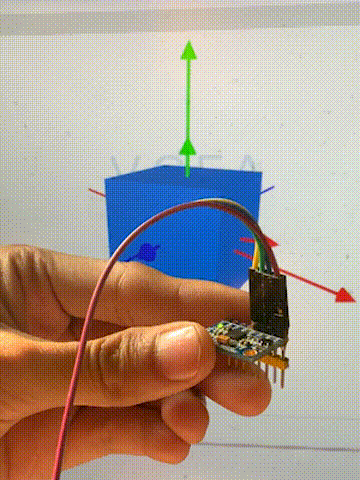STC89C516 32MHz
Keil uVision V5.29.0.0
PK51 Prof.Developers Kit Version:9.60.0.0
上位机:Vofa+ 1.3.10
移植自AHRS —— LOXO,算法作者:SOH Madgwick
源码
为了避免所用RAM超标,部分变量设为idata类型,移植时需注意。
所用MCU为STC89C516 晶振16MHz 6T模式
stdint.h见【51单片机快速入门指南】1:基础知识和工程创建
软件I2C程序见【51单片机快速入门指南】4: 软件 I2C
串口部分见【51单片机快速入门指南】3.3:USART 串口通信
MPU6050.c、MPU6050.h见【51单片机快速入门指南】4.3: I2C读取MPU6050陀螺仪的原始数据
beta要按需调整,我这里取0.1
Madgwick_6.c
//=====================================================================================================
//
// Implementation of Madgwick's IMU and AHRS algorithms.
// See: http://www.x-io.co.uk/node/8#open_source_ahrs_and_imu_algorithms
//
// Date Author Notes
// 29/09/2011 SOH Madgwick Initial release
// 02/10/2011 SOH Madgwick Optimised for reduced CPU load
// 19/02/2012 SOH Madgwick Magnetometer measurement is normalised
//
//=====================================================================================================
//---------------------------------------------------------------------------------------------------
// Header files
#include <math.h>
#include "MPU6050.h"
//---------------------------------------------------------------------------------------------------
// Definitions
#define beta 0.1f // 2 * proportional gain (Kp)
//---------------------------------------------------------------------------------------------------
// Variable definitions
idata volatile float q0 = 1.0f, q1 = 0.0f, q2 = 0.0f, q3 = 0.0f; // quaternion of sensor frame relative to auxiliary frame
idata volatile float Pitch = 0.0f, Roll = 0.0f, Yaw = 0.0f;
//====================================================================================================
// Functions
idata float sampleFreq = 1;
idata float GYRO_K = 1;
void MPU6050_Madgwick_Init(float loop_ms)
{
sampleFreq = 1000. / loop_ms; //sample frequency in Hz
switch((MPU_Read_Byte(MPU_GYRO_CFG_REG) >> 3) & 3)
{
case 0:
GYRO_K = 1./131/57.3;
break;
case 1:
GYRO_K = 1./65.5/57.3;
break;
case 2:
GYRO_K = 1./32.8/57.3;
break;
case 3:
GYRO_K = 1./16.4/57.3;
break;
}
}
//---------------------------------------------------------------------------------------------------
// Fast inverse square-root
// See: http://en.wikipedia.org/wiki/Fast_inverse_square_root
float invSqrt(float x)
{
float halfx = 0.5f * x;
float y = x;
long i = *(long*)&y;
i = 0x5f3759df - (i>>1);
y = *(float*)&i;
y = y * (1.5f - (halfx * y * y));
return y;
}
//---------------------------------------------------------------------------------------------------
// AHRS algorithm update
//---------------------------------------------------------------------------------------------------
// IMU algorithm update
void MadgwickAHRSupdate_6(float gx, float gy, float gz, float ax, float ay, float az)
{
float recipNorm;
float s0, s1, s2, s3;
float qDot1, qDot2, qDot3, qDot4;
float _2q0, _2q1, _2q2, _2q3, _4q0, _4q1, _4q2 ,_8q1, _8q2, q0q0, q1q1, q2q2, q3q3;
//将陀螺仪AD值转换为 弧度/s
gx = gx * GYRO_K;
gy = gy * GYRO_K;
gz = gz * GYRO_K;
// Rate of change of quaternion from gyroscope
qDot1 = 0.5f * (-q1 * gx - q2 * gy - q3 * gz);
qDot2 = 0.5f * (q0 * gx + q2 * gz - q3 * gy);
qDot3 = 0.5f * (q0 * gy - q1 * gz + q3 * gx);
qDot4 = 0.5f * (q0 * gz + q1 * gy - q2 * gx);
// Compute feedback only if accelerometer measurement valid (avoids NaN in accelerometer normalisation)
if(!((ax == 0.0f) && (ay == 0.0f) && (az == 0.0f))) {
// Normalise accelerometer measurement
recipNorm = invSqrt(ax * ax + ay * ay + az * az);
ax *= recipNorm;
ay *= recipNorm;
az *= recipNorm;
// Auxiliary variables to avoid repeated arithmetic
_2q0 = 2.0f * q0;
_2q1 = 2.0f * q1;
_2q2 = 2.0f * q2;
_2q3 = 2.0f * q3;
_4q0 = 4.0f * q0;
_4q1 = 4.0f * q1;
_4q2 = 4.0f * q2;
_8q1 = 8.0f * q1;
_8q2 = 8.0f * q2;
q0q0 = q0 * q0;
q1q1 = q1 * q1;
q2q2 = q2 * q2;
q3q3 = q3 * q3;
// Gradient decent algorithm corrective step
s0 = _4q0 * q2q2 + _2q2 * ax + _4q0 * q1q1 - _2q1 * ay;
s1 = _4q1 * q3q3 - _2q3 * ax + 4.0f * q0q0 * q1 - _2q0 * ay - _4q1 + _8q1 * q1q1 + _8q1 * q2q2 + _4q1 * az;
s2 = 4.0f * q0q0 * q2 + _2q0 * ax + _4q2 * q3q3 - _2q3 * ay - _4q2 + _8q2 * q1q1 + _8q2 * q2q2 + _4q2 * az;
s3 = 4.0f * q1q1 * q3 - _2q1 * ax + 4.0f * q2q2 * q3 - _2q2 * ay;
recipNorm = invSqrt(s0 * s0 + s1 * s1 + s2 * s2 + s3 * s3); // normalise step magnitude
s0 *= recipNorm;
s1 *= recipNorm;
s2 *= recipNorm;
s3 *= recipNorm;
// Apply feedback step
qDot1 -= beta * s0;
qDot2 -= beta * s1;
qDot3 -= beta * s2;
qDot4 -= beta * s3;
}
// Integrate rate of change of quaternion to yield quaternion
q0 += qDot1 * (1.0f / sampleFreq);
q1 += qDot2 * (1.0f / sampleFreq);
q2 += qDot3 * (1.0f / sampleFreq);
q3 += qDot4 * (1.0f / sampleFreq);
// Normalise quaternion
recipNorm = invSqrt(q0 * q0 + q1 * q1 + q2 * q2 + q3 * q3);
q0 *= recipNorm;
q1 *= recipNorm;
q2 *= recipNorm;
q3 *= recipNorm;
Pitch = asin(-2.0f * (q1*q3 - q0*q2))* 57.3f;
Roll = atan2(q0*q1 + q2*q3, 0.5f - q1*q1 - q2*q2) * 57.3f;
Yaw = atan2(q1*q2 + q0*q3, 0.5f - q2*q2 - q3*q3)* 57.3f;
}
//====================================================================================================
// END OF CODE
//====================================================================================================
Madgwick_6.h
#ifndef Madgwick_6_H_
#define Madgwick_6_H_
extern idata float Pitch, Roll, Yaw;
extern idata float q0, q1, q2, q3;
void MPU6050_Madgwick_Init(float loop_ms);
void MadgwickAHRSupdate_6(float gx, float gy, float gz, float ax, float ay, float az);
#endif
使用方法
先调用MPU6050_Madgwick_Init(dt),参数为一次循环的时间,单位为ms
再使用MadgwickAHRSupdate_6姿态融合函数。
测试程序
main.c
#include <STC89C5xRC.H>
#include "intrins.h"
#include "stdint.h"
#include "USART.h"
#include "./MPU6050/MPU6050.h"
#include "./MPU6050/Madgwick_6.h"
void Delay1ms() //@32MHz
{
unsigned char i, j;
i = 6;
j = 44;
do
{
while (--j);
} while (--i);
}
void Delay_ms(int i)
{
while(i--)
Delay1ms();
}
void main(void)
{
idata int16_t aacx,aacy,aacz; //加速度传感器原始数据
idata int16_t gyrox,gyroy,gyroz; //陀螺仪原始数据
USART_Init(USART_MODE_1, Rx_ENABLE, STC_USART_Priority_Lowest, 32000000, 4800, DOUBLE_BAUD_DISABLE, USART_TIMER_2);
MPU_Init();
MPU6050_Madgwick_Init(95);
while(1)
{
MPU_Get_Accelerometer(&aacx, &aacy, &aacz); //得到加速度传感器数据
MPU_Get_Gyroscope(&gyrox, &gyroy, &gyroz); //得到陀螺仪数据
MadgwickAHRSupdate_6(gyrox, gyroy, gyroz, aacx, aacy, aacz);
printf("%f, ", Pitch);
printf("%f, ", Roll);
printf("%f\r\n", Yaw);
}
}
效果

























 465
465











 被折叠的 条评论
为什么被折叠?
被折叠的 条评论
为什么被折叠?










